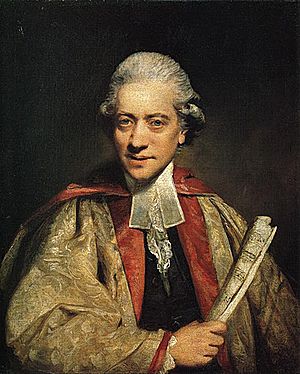Charles Burney facts for kids

Charles Burney (born April 7, 1726 – died April 12, 1814) was an English music historian, composer, and musician. He was a very important person in the world of music during his time. Charles Burney was the father of several famous writers, including Frances Burney and Sarah Burney. He was also the father of the explorer James Burney. Burney was a close friend and supporter of the famous composer Joseph Haydn.
Contents
Early Life and Music Career
Charles Burney was born in Shrewsbury, England. He was one fourth of six children. His father, James Macburney, was also a musician and painter. Charles started learning music early. His first music teacher was Mr. Baker, who was the organist at the cathedral in Chester.
When he was 15, Burney continued his music studies with his half-brother, James Burney, who was an organist. Later, he moved to London to study with Dr. Thomas Arne, a well-known composer.
In 1749, Charles became the organist at St Dionis Backchurch in London. He also played the harpsichord in new concerts. For his health, he moved to Lynn Regis in Norfolk in 1751. He worked there as an organist for nine years. During this time, he started thinking about writing a complete history of music.
He returned to London in 1760. His eldest daughter, Esther, was only eight years old, but she was already a very talented harpsichord player. Burney published some harpsichord concertos, which were very popular. In 1766, he adapted a French opera by Jean-Jacques Rousseau into English, calling it The Cunning Man.
Family and Friends
In 1749, Charles Burney married Esther Sleepe. They had six children together. Their children included Esther, the explorer James Burney, and the famous writer Frances Burney, also known as Fanny.
The Burney family was part of a lively group of artists and writers in London. They knew important people like the painter Sir Joshua Reynolds, the writer Samuel Johnson, and the composer Joseph Haydn.
After Esther died in 1761, Charles married Elizabeth Allen in 1767. With Elizabeth, he had two more children, including Sarah Burney, who also became a novelist.
Later Career and Music History
In 1769, the University of Oxford gave Charles Burney degrees in music. He even performed some of his own music there. Burney was very focused on his big project: writing a History of Music. To gather information, he decided to travel to other countries.
In 1770, he traveled to Paris, Geneva, and many cities in Italy. In Bologna, he met the famous young composer Wolfgang Amadeus Mozart and his father. Burney wrote about his travels in a popular book called The Present State of Music in France and Italy (1771).
He traveled again in 1772 to Germany and the Netherlands. He published another book about this trip. In 1773, he became a member of the Royal Society, a group for important scientists and thinkers.
In 1776, the first volume of his major work, History of Music, was published. He published the other volumes in 1782 and 1789. This history book was generally well-liked. It covered the development of opera and the music scene in England during his time.
Burney also wrote other musical works. In 1785, he wrote about the first big event celebrating the composer George Friedrich Handel at Westminster Abbey. He also wrote about the life of Handel. Later in his life, he contributed many music articles to a large encyclopedia called Rees's Cyclopædia.
In 1783, he became the organist at Chelsea Hospital. He lived there for the rest of his life. Charles Burney admired Joseph Haydn very much. He even wrote a poem for Haydn. Burney died on April 12, 1814, and was buried at Chelsea College. A special plaque was placed in Westminster Abbey to remember him.
Portraits and Family Accounts
Many artists painted Charles Burney's portrait. Joshua Reynolds painted him in 1781. There was also a sculpture of him made in 1805. He knew many famous artists and writers of his time.
His eldest son, James Burney, became a respected officer in the Royal Navy. He traveled with Captain Cook on his last two voyages. His daughter, Frances, or Fanny, became a very famous novelist. Her published diaries and letters tell us a lot about her father's life and his friends. Another daughter, Sarah Burney, also became a novelist. Her letters give us more details about her father.
Music Compositions
Here are some of the musical pieces Charles Burney composed:
- The Cunning Man, an opera he adapted from a French one (1766–67)
- Six Sonatas for the harpsichord (1761)
- Two Sonatas for harpsichord or piano, with parts for violin and cello (1769 and 1772)
- Sonatas for two violins and a bass, op. 4 (1759)
- Six Lessons for the harpsichord
- Six Duets for two German flutes
- Three Concertos for the harpsichord
- Six Cornet Pieces with an introduction and fugue for the organ
- Six Concertos for the violin, etc., in eight parts, op. 5 (around 1760)
- Two Sonatas for pianoforte, violin, and cello
- Four Sonatas or Duets for two Performers on One Piano Forte or Harpsichord (1777)
- Anthems and other church music
- 6 Songs composed for the Temple of Apollo, book 1, op. 2 (around 1750)
- I will love thee, O Lord my strength (Psalm xviii), a piece for solo, chorus, and orchestra (1769)
- XII. Canzonetti a due voci in Canone, with poetry by Metastasio (around 1790)
- Preludes, Fugues, and Interludes; for the Organ, a book for young organists.
See also
 In Spanish: Charles Burney para niños
In Spanish: Charles Burney para niños
- Gott erhalte Franz den Kaiser – a poem translated by Burney

